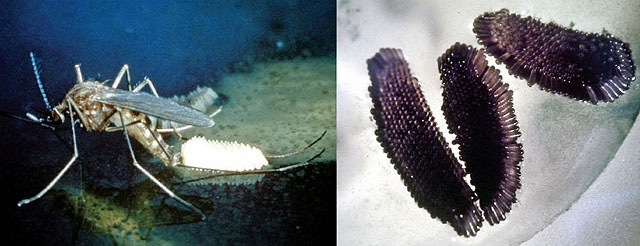West Nile Virus
West Nile Virus (WNV) was first discovered in the United States in New York City
during 1999. It has since spread south and west with confirmation in northern Illinois during
2001. In 2002, an epidemic of WNV in Illinois resulted in 884 human cases of the disease with
66 deaths.
WNV cycles between mosquitoes and birds, with
occasional spill-over into humans and other mammals. The virus can have a high mortality in
certain bird species while having little effect on other bird species. Crows and Blue Jays
are extremely susceptible to the virus, as are eagles, hawks, and other raptors.
Humans are considered a dead-end host for the virus, which means cannot be transmitted from person to
person or back to mosquitoes.
WNV affects the central nervous system causing an inflammation of the brain. Most
human infections are mild and subclinical (not diagnosed). Symptoms associated with mild
cases of WNV are low fever, headache, body aches, and swollen lymph glands. Less than 1%
of people infected with WNV will develop severe illness. In more severe cases, symptoms can
be high fever, neck stiffness, muscle weakness, stupor, coma, tremors, paralysis, and in
3-15% of severe human infections, death. People over 50 are most susceptible to WNV, but
all ages are at risk.
 Mosquitoes from the genus Culex, in particular the species Culex pipiens, are the main vectors of
WNV. These mosquitoes deposit their eggs in raft clusters of 50-400 eggs directly on the water's surface. They are most abundant in periods
lacking rainfall, when areas of stagnant water prevail. They are well adapted to many habitats
including curbside storm water catch basins, off-road storm water catch basins, discarded
tires, buckets & other artificial containers, rain gutters, bird baths, unused swimming pools,
ditches, ponds, etc. Anywhere that water can stand for more than a week can become a
breeding source for Culex mosquitoes.
Mosquitoes from the genus Culex, in particular the species Culex pipiens, are the main vectors of
WNV. These mosquitoes deposit their eggs in raft clusters of 50-400 eggs directly on the water's surface. They are most abundant in periods
lacking rainfall, when areas of stagnant water prevail. They are well adapted to many habitats
including curbside storm water catch basins, off-road storm water catch basins, discarded
tires, buckets & other artificial containers, rain gutters, bird baths, unused swimming pools,
ditches, ponds, etc. Anywhere that water can stand for more than a week can become a
breeding source for Culex mosquitoes.
 Adult Culex spp. mosquitoes are non-aggressive biters, often going unnoticed,
with feeding primarily confined to evening or night hours. They seldom travel
more than 1/2 mile from its source. Additionally, these mosquitoes can have many over-lapping
generations each season, and over-winter as adults.
Adult Culex spp. mosquitoes are non-aggressive biters, often going unnoticed,
with feeding primarily confined to evening or night hours. They seldom travel
more than 1/2 mile from its source. Additionally, these mosquitoes can have many over-lapping
generations each season, and over-winter as adults.
The surveillance and control of Culex spp. mosquitoes is very crucial in the efforts to reduce as
much as possible the occurrence of WNV.
